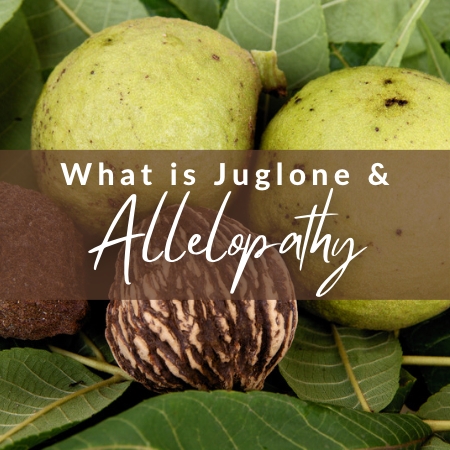What is Juglone?
Juglone is a chemical produced by certain plant species and it causes an allelopathic affect on the plants around it.
What is allelopathy
Allelopathy is a biological ‘behaviour’ which is known to inhibit the growth of surrounding species in order to influence germination, growth and survival of its saplings.
To put it simply, some trees suppress the growth of others in order to improve its species survival rate! Prison rules! This chemical interaction can be a frustration for gardeners but it doesn’t have to be! Read on for some tips, advice, and a guild examples…
Which trees have Juglone?
ALL species of the Juglandaceae family. Black Walnut trees have the highest amount, but Hickory, Butternut, and Pecan trees also contain this suppressant. These are highly competitive trees which makes sense given how long it takes for them to fully mature and ‘go to seed’!
Is Juglone toxic to humans and livestock?
All parts of these trees produce Juglone. That’s the leaves, stems, fruit, etc.! But scientists have found that the fruit, roots and hulls actually have the highest concentrations! We have been told that walnuts are good for our health and they’re being used in dyes and different formulas for skin and hair products. They’re even being used as a natural pesticide. However, the pollen can cause allergic type symptoms in humans and livestock. So can wood chips or sawdust from this species. Anyone with a known nut allergy should avoid these nuts and consult with their medical practitioner before eating or applying to skin. Scientists are even saying that juglone has a similar effect on humans as cyanide does! Even small amounts of pure Juglone can cause illness or even death in humans and animals.
Exposure to animals, horses in particular, has been found to be particularly bad! Horses and ponies can experience contact dermatitis as well as a type of vascular disease called equine laminitis. While these make wonderful shade trees, and are great for stabilising slopes, they should be avoided when planning pastures for livestock and horses.
Can I compost plant Juglone materials?
Yes! You can compost the leaves and fruits of these trees. In approximately 2-4 weeks the toxin will start to break down due to oxidation, water and fungi. In native soils though, this breakdown can take 2 – 3 times as long! You’ll need to wait 6 months before applying this compost to your gardens to make sure the suppressant is completely broken down.
What can grow under or near these trees?
Kentucky Bluegrass
Japanese Maples, in fact most maples except silver maple.
Eastern Redbud
Weeping Forsythia
Tartarian Honeysuckle
Eastern Red Cedar
Virginia Creeper
Black Raspberry
Arborvitaes
Pansy
Morning Glory
Squash and Melons
American Pawpaw
Hickory
Sycamore
Black Cherry
Black and honey locust
Persimmon
Sassafras
Beech
Beans
Carrots
Corn
Peaches and Plums
Cherry and Nectarines
Hollyhock
Jerusalem artichoke
Daylily
Coral Bells
Hostas
Mayapple
Lungwort
Ohio Buckeye
Gooseberry
Mulberry
Lettuce
Strawberries
Elderberry
Motherwort
Violets
Hackberry
What can’t grow under or near these trees?
Blackberry
Blueberry
Potatoes
Tomatoes
Azaleas
Mountain Laurel
Rhubarb
Asparagus
Apple or Crabapple
Peonies
Chokeberry
Cabbage
Peppers
Eggplant
Working with Juglone trees doesn’t have to be impossible. There are so many more plants that are tolerant to this chemical! When building your guilds or designing your garden around juglone, do your research on native juglone-tolerant plants or ones most suitable for your climate and growing zone. Position those plants appropriately based on sun/shade/wind protection/irrigation or dripline. You can have a wonderful, productive, edible, or native garden despite nature’s chemical warfare.



